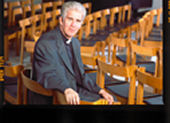
When ordained Lutheran pastor Craig Satterlee ’98M.A., ’00Ph.D.was waiting for his first call to parish ministry, he was told that people with sight impairments were meant to be ministered to, not to be ministers.
A parish did extend a call, but at a reduced salary. “That was the only way they could justify having a pastor who couldn’t see,” Satterlee says.
Satterlee has been legally blind since birth and has only 20 percent of normal vision, with correction. “What that means, I don’t know,” he says. “I’ve been this way my whole life. I can see color. I can make out people. I don’t drive, and I miss small details, like holes in sidewalks.”
Satterlee eventually began work at a church in Endicott, New York, first as a part-time assistant pastor, then full time and, finally, as the pastor. Later while in graduate school at Notre Dame, he served as an interim pastor in Sturgis, Michigan.
Soon after receiving his doctorate, Satterlee accepted a job as assistant professor of homiletics (“teaching preaching,” he clarifies cheerfully) at the Lutheran School of Theology at Chicago. He also serves as co-director of the school’s Doctor of Ministry Program.
Today he lives and works on the Hyde Park campus with wife, Cathy, and 10-year-old daughter, Chelsey. Cathy is the family driver, but Satterlee is able to live and work independently, using mass transit or walking to get around.
The appointment at the theology school allows him time to teach, write and work with students. He also conducts continuing education seminars for pastors around the country and continues to preach on Sundays, either as a speaker representing the seminary or as guest clergy. But Satterlee especially enjoys teaching homiletics, the art of preaching, to young seminary students.
“What I get to do is accompany students who feel they have a call to the ELCA [Evangelical Lutheran Church in America] to discover and claim their voice as proclaimers of Jesus Christ. What I find exciting is when they preach the Gospel and realize that they have a unique voice. That they have good news to share that the world needs to hear.”
Satterlee sees his Sunday preaching as an important part of what he brings to his students. “In order to teach it, I need to be doing it,” he says.
In addition to his Lutheran theology students, Satterlee also has taught a number of students from Chicago’s Catholic Theological Union, who registered for his classes after learning of his connection to Notre Dame.
The former Eagle Scout attributes his success to his parents, Helen and Don, who were determined from the start that he would attend the Roseville, Michigan, public schools rather than a school for the blind. “They insisted that I was not going to be treated differently. They said, until I was worse academically than the worst kid in school, I would go to public schools.”
In his sermons, Satterlee often tells the story of a particularly galling experience he had at Roseville High School. A substitute teacher in his 10th grade Spanish class looked at him, then dramatically announced: “There is hope in the world! We can make you see!” Faith healer Kathryn Kuhlman, she said, could cure his eyes and make him “normal.”
“My parents raised me to believe there was nothing wrong with me,” he says, “Nothing bad. I have two brothers, and we were all raised the same, except that I didn’t see well.”
The teacher’s remarks, Satterlee says, stunned and humiliated him. He angrily fled the classroom, to the applause of the other students. The teacher, he later learned, was asked to leave the school.
He encountered the same belief system in his second year of seminary. He was participating in an urban ministry project at a Pentecostal church in Detroit, shadowing city pastors and meeting with social service agencies, and he was once again told that his eyes could be healed. His experiences have led Satterlee to a view that moves from the notion of healing-as-cure to a view of healing as God’s presence in suffering. There can be healing and wholeness, Satterlee says, even where there can be no cure. “I am whole, even though I am legally blind.”
Satterlee is often introduced as a pastor who believes in the power of prayer. “I take that as a compliment, which is the way it’s intended,” he says, “but I don’t believe in the power of prayer. I believe in the power and presence of God, and so I pray.”
Rather like those faith healers Satterlee remembers so well, people often pray as if they’re doing magic, he notes. “But we know that God brings light out of darkness, life out of death, hope out of despair. That’s what Scripture teaches us.”
Carol Bradley is a freelance writer and photographer who lives in South Bend.
Notre Dame Magazine, Summer 2002